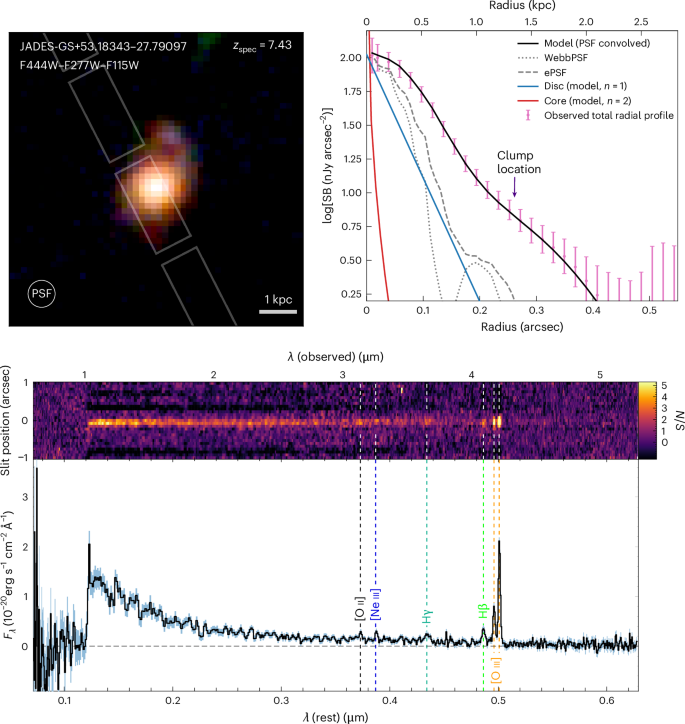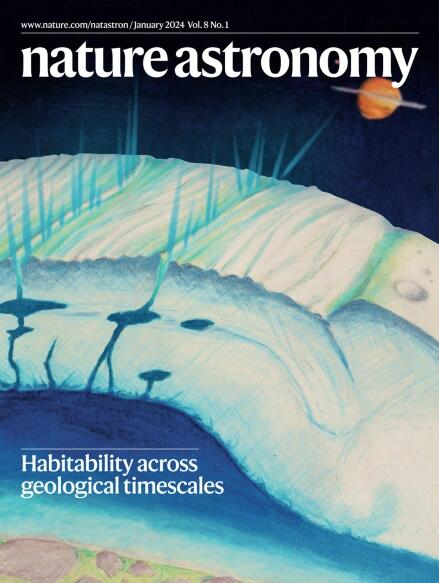A core in a star-forming disc as evidence of inside-out growth in the early Universe
IF 12.9
1区 物理与天体物理
Q1 ASTRONOMY & ASTROPHYSICS
引用次数: 0
Abstract
The physical processes that establish the morphological evolution and the structural diversity of galaxies are key unknowns in extragalactic astrophysics. Here we report the finding of the morphologically mature galaxy JADES-GS+53.18343−27.79097, which existed within the first 700 million years of the Universe’s history. This star-forming galaxy with a stellar mass of 400 million solar masses consists of three components: a highly compact core with a half-light radius of less than 100 pc, an actively star-forming disc with a radius of about 400 pc and a star-forming clump, all of which show distinctive star-formation histories. The central stellar mass density of this galaxy is within a factor of 2 of the most massive present-day ellipticals, while being globally 1,000 times less massive. The radial profile of the specific star-formation rate is rising towards the outskirts. This evidence suggests a detection of the inside-out growth of a galaxy as a proto-bulge and a star-forming disc in the epoch of reionization. Evidence is found for a distant galaxy growing inside-out within the first 700 million years of the Universe. The galaxy has a dense central core comparable in mass density to local massive ellipticals, and an extended star-forming disc.


恒星形成盘中的核心是早期宇宙由内而外生长的证据
确定星系形态演变和结构多样性的物理过程是河外星系天体物理学的关键未知因素。在这里,我们报告了形态成熟的星系JADES-GS+53.18343-27.79097的发现,它存在于宇宙历史的前7亿年。这个恒星质量为4亿个太阳质量的恒星形成星系由三个部分组成:半光半径小于100 pc的高度紧凑核心、半径约为400 pc的活跃恒星形成圆盘和恒星形成团块,它们都显示出独特的恒星形成历史。这个星系的中心恒星质量密度与现今质量最大的椭圆星系相差不到 2 倍,而在全球范围内质量却要小 1000 倍。特定恒星形成率的径向曲线向外围上升。这些证据表明,在再电离时代发现了一个由内而外生长的星系,即原初星系和恒星形成盘。
本文章由计算机程序翻译,如有差异,请以英文原文为准。
求助全文
约1分钟内获得全文
求助全文
来源期刊

Nature Astronomy
Physics and Astronomy-Astronomy and Astrophysics
CiteScore
19.50
自引率
2.80%
发文量
252
期刊介绍:
Nature Astronomy, the oldest science, has played a significant role in the history of Nature. Throughout the years, pioneering discoveries such as the first quasar, exoplanet, and understanding of spiral nebulae have been reported in the journal. With the introduction of Nature Astronomy, the field now receives expanded coverage, welcoming research in astronomy, astrophysics, and planetary science. The primary objective is to encourage closer collaboration among researchers in these related areas.
Similar to other journals under the Nature brand, Nature Astronomy boasts a devoted team of professional editors, ensuring fairness and rigorous peer-review processes. The journal maintains high standards in copy-editing and production, ensuring timely publication and editorial independence.
In addition to original research, Nature Astronomy publishes a wide range of content, including Comments, Reviews, News and Views, Features, and Correspondence. This diverse collection covers various disciplines within astronomy and includes contributions from a diverse range of voices.
 求助内容:
求助内容: 应助结果提醒方式:
应助结果提醒方式:


